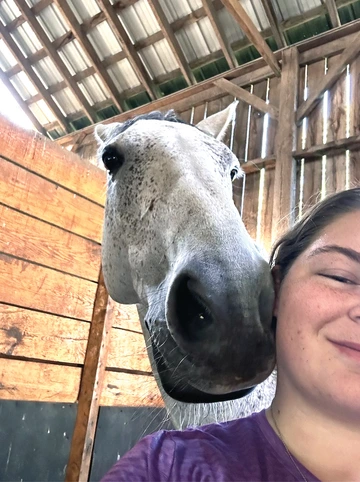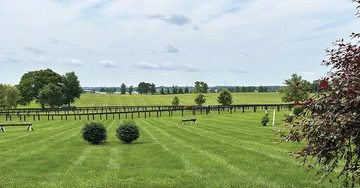Ali Evans: Spy Coast Farm

I spent two-weeks as an intern at Spy Coast Farm in Lexington, KY, in late May of this year. I spent most of my time in one barn with the same team, working with young warmbloods aged four to six in their Young Horse Development Program. On my first day, mere minutes after being introduced to the manager, I was sent out to a pasture with others to catch a few horses and bring them into the barn as part of their seasonal rotation. I was able to spend time with and get to know each horse, their preferences and how to handle them properly. After a while, I was asked to hold two-year-olds in a pasture - in the rain, without a proper halter - for a farrier. We had a bucket of pellets to lure them to us and had to make a makeshift halter out of a lead rope and hold them steady. Toward the end of my time there, I went to a different barn where I got to handle two- to three-year-olds and see how they broke them. I got to be involved in the process of getting them used to things being thrown over their backs, having a saddle sitting there, and even putting weight on their backs

After that, I shadowed their veterinarian to various farms and got to learn many different things. Our first stop was Burleson Farms to treat a weanling for a respiratory infection; he was not happy about how many people were in the stall. They eventually got the needed blood sample and went on to do many caslick’s procedures and ultrasounds. Dr. Modesty Burleson showed me how to ultrasound a horse and she taught me the meaning of the different densities and sizes, how to do a caslick’s procedure, why we go through the process, and everything that goes into breeding Thoroughbreds. She took me through the process of booking a stallion to breed to her mare including how she picked them, the importance of timing, and the medications to aid in the timing of each breeding. She even took me to watch the covering and the aftercare for the mare. It was at that time she got a call about a horse colicing at Spy Coast, so we rushed over there. Another intern and I stood with the horse to ensure she didn’t roll. I got to witness and aid in the treatment and care of this horse, which was a little scary at the beginning, but I just tried to stay out of the way at first. The horse ended up being fine, thanks to Dr. Burleson and her help with NG tube placement.
On one of my last days there, I got to help with a foaling during which the mare had a difficult birth. She had a red bag, and I got to watch as the tech on duty called the vet and followed her instructions. We got to stay with the mare and foal for a couple hours, and the foal would even stand up and walk around while mom was still on the floor. He was suckling on our fingers and was said to be super friendly as he grew up a little bit, likely due to those initial moments of human interaction. – Ali Evans

